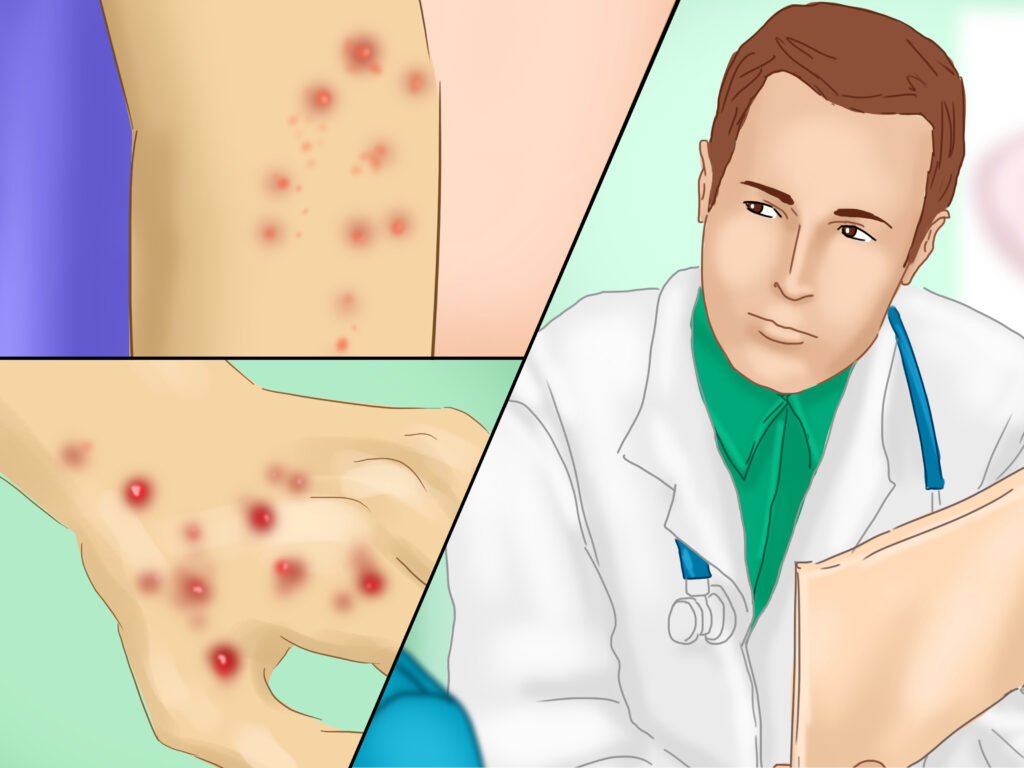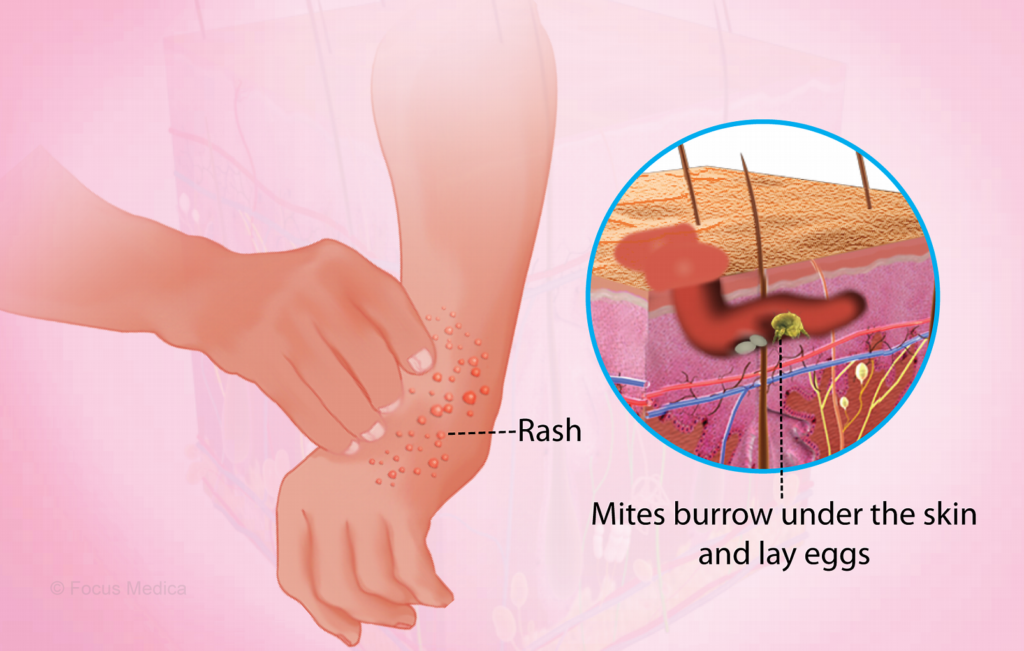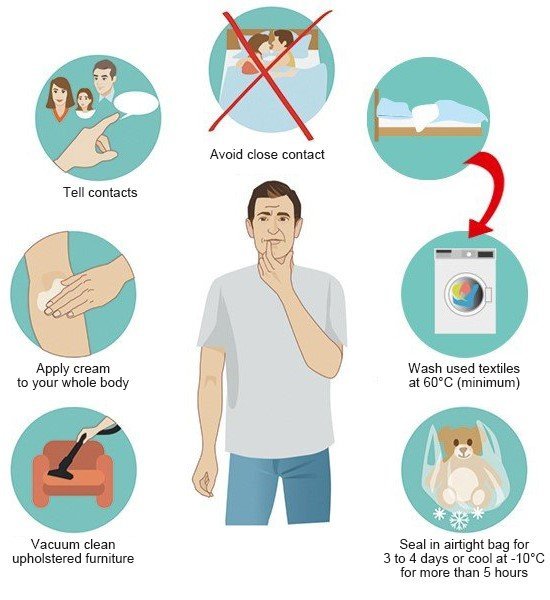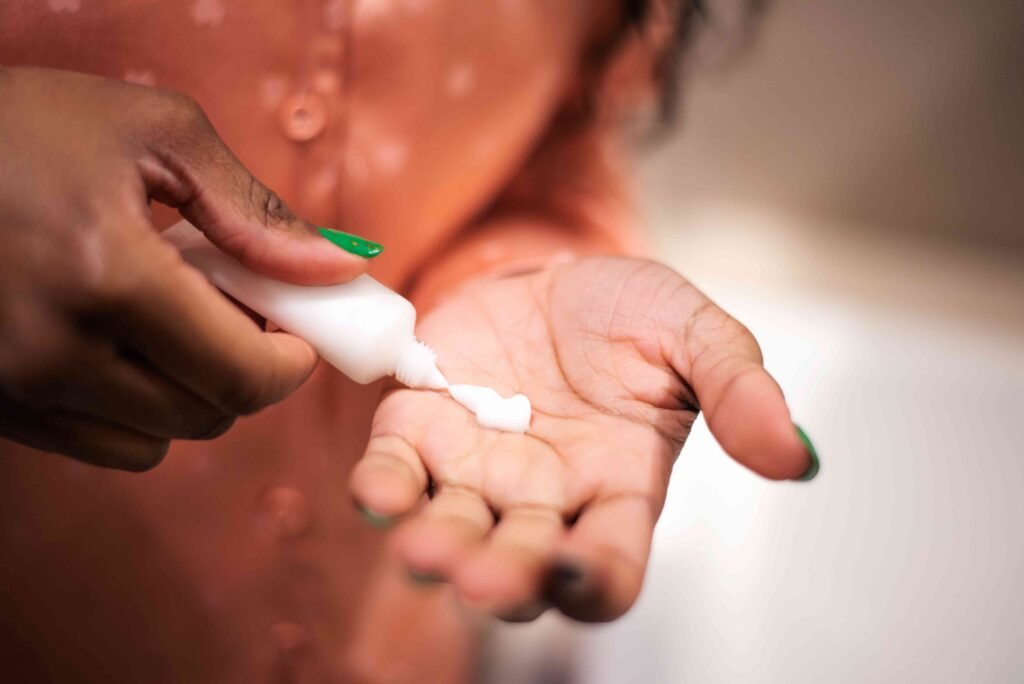Recognizing Symptoms and Seeking Early Treatment
Knowing how to cure scabies starts with recognizing the symptoms early. Scabies is a highly contagious skin condition that causes intense itching, which can last for weeks or even months without proper treatment. Common signs include severe itching—especially at night—and small red bumps or rash-like patches on the skin. These often appear on the wrist, armpit, elbow, between the fingers, genital area, waist, and beltline. You might also notice small, light-gray burrow lines that are slightly raised between the bumps.

A rare and more severe type, called Norwegian or crusted scabies, causes thick grayish crusts filled with thousands of mites and eggs. This form mainly affects people with weakened immune systems. If you’ve been exposed to someone with scabies, it’s vital to recognize these symptoms early and understand how to cure scabies through prompt treatment.
How to Recognize the Signs of Scabies and Early Symptoms
Any case of severe itching that lasts weeks or months could result from scabies. Signs of scabies include:

- Intense itching, especially at night.
- Small red bumps (they may be pimple-like) appear on the skin like a rash. The rash can be on the whole body or limited to certain areas. Common places include the wrist, armpit, elbow between fingers, genital area, waist, and beltline. The rash can also have small blisters.
- Small burrow lines between the bumps. They are typically light gray and slightly raised.
- Norwegian scabies, or “crusted scabies,” is a particularly severe form. Signs of crusted scabies include thick crusts on the skin that crumble easily and may appear greyish. They contain hundreds of thousands of mites and eggs. Crusted scabies is rare and typically seen in patients with suppressed immune systems
- Be particularly vigilant of these symptoms if you have been in contact with anyone infected with scabies.
When to Visit the Doctor for Scabies Treatment and Advice
It is important that you visit your doctor. Over-the-counter and home remedies will not treat the infestation completely.
- The doctor will usually only need to see the rash to diagnose the condition. He might also take a sample by scraping under the bumps and looking for the presence of mites, eggs, and feces under the microscope.
- Be sure to tell your doctor if you are pregnant or have any problems such as serious illness, or other severe skin diseases.
- Everyone that has come into contact with a patient diagnosed with scabies should also be evaluated by a doctor.
How to Cure Scabies: Treat the Itch Yourself While You Wait

If you’re wondering how to cure scabies and need immediate relief, there are several self-care methods you can try while waiting for your doctor’s appointment or prescription. Soaking in cold water or applying calamine lotion can help soothe the intense itching caused by scabies. Over-the-counter oral antihistamines, such as cetirizine (Zyrtec) or diphenhydramine hydrochloride (Benadryl), may also reduce itching and discomfort temporarily. However, understanding how to cure scabies properly involves consulting a healthcare professional who can prescribe the most effective medication. Following professional advice is essential not only to relieve symptoms but also to prevent further spread of the infestation. Learning how to cure scabies effectively with the right treatments ensures a quicker recovery and protects both you and those around you from reinfestation.
How to Cure Scabies: Get a Prescription for Effective Treatment
Once diagnosed, your doctor will usually prescribe a mite-killing cream or lotion containing five percent Permethrin. Always follow your doctor’s and pharmacist’s instructions exactly when using the cream.
- Permethrin is topically applied and has a few side effects such as burning/stinging and itching.
- Permethrin only kills mites and not ova (eggs), so a second application is necessary for treatment. Two applications at least one week apart (this is how long it takes an egg to hatch) is the minimum treatment required to make sure it is eradicated.
- For people with a severe infestation and weakened immune system, doctors may prescribe Ivermectin as an oral treatment. Ivermectin is an oral medication. It is generally used for crusted scabies and taken as a single one-time dose. Some doctors may prescribe a second dose after one week. Side effects of Ivermectin include fever/chills, headache, loss of appetite, joint pain and rash.
- Your doctor may prescribe other creams instead of the Permethrin. These include Crotamiton 10%, Lindane 1%, or sulfur 6%. These are less common, and are used if a patient has failed treatment with Permethrin or Ivermectin. Treatment failure is frequent with Crotamiton. Side effects of Crotamiton include rash and itching. Lindane is toxic if overused or misused. Side effects of Lindane include seizures, and rash.
How to Cure Scabies: Exploring Herbal Remedies for Relief

Several herbs are traditionally used for treating scabies. There is little proof that these remedies are effective — most evidence is anecdotal, or people saying they were helpful, but there is no scientifically backed evidence to support their use. Currently the only proven remedy is prescription medication. Do not rely on these treatments alone. Talk to your doctor before trying any herbal remedies, including the following:
- Devil’s horsewhip or prickly chaff flower (Achyranthes aspera)
- Neem (Azadirachta indica)
- Karanja (Pongamia pinnata)
- Turmeric (Curcuma longa)
- Blue gum or camphor oil (Eucalyptus globulus)
- Fig bark powder (‘Ficus carica, Ficus racemosa, Ficus benghalensis)
Understanding How to Cure Scabies: Treatment Options Explained
Learn about the common medications and therapies used to treat scabies effectively.
Prescription Medications for Scabies
Details on topical creams, lotions, and oral medications prescribed by doctors to eliminate scabies mites.
Home Care Tips During Treatment
Important steps to take at home to support treatment, including hygiene practices and cleaning your environment.
Managing Itching and Skin Irritation
Ways to relieve itching and soothe irritated skin while undergoing treatment.
When to See a Doctor
If you are still unsure how to cure scabies after completing your initial treatment, or if your symptoms persist or worsen despite following all instructions carefully, it’s crucial to consult a healthcare professional. Knowing how to cure scabies properly means recognizing when to seek further medical advice, especially if severe itching, widespread rash, or signs of infection such as increased redness, swelling, or pus develop. People with weakened immune systems or other underlying health conditions should be particularly vigilant about understanding how to cure scabies effectively and seek early care. If you ever feel uncertain about your symptoms or treatment progress, don’t hesitate to ask a medical expert for guidance on how to cure scabies safely and thoroughly.
Signs that you should seek medical advice if symptoms persist or worsen despite treatment.
Shower and towel-dry your body using a fresh, clean towel. Wait a while for your body to cool down some from the shower before applying your medication.
Apply the prescription cream or lotion. Unless a medical professional advised you otherwise, start behind the ears and from the jawline and work your way down. Apply using cotton wool swabs, a paintbrush, a sponge, or any item supplied with the treatment for the purpose.
- Continue rubbing the cream downward, over your entire body. Avoid the eyes, nose, and mouth area, but apply everywhere else. You must cover your genitals, soles of your feet, between your toes, back, and buttocks. Get help for areas you’re not able to reach yourself.
- After covering your body, take care of your hands. Apply between the fingers and under your nails. You will need to reapply the cream to your hands every time you wash them.
Wait. Leave the lotion or oil on your body for the amount of time directed. This is usually between eight to 24 hours.
- The length of time you’ll need to leave the medication on your skin will depend on the product and your doctor’s instructions.
Shower off the cream or lotion. Once the allotted time is up, wash off the medication under a warm shower. Be aware that you may remain itchy for a few weeks after the treatment.

- This is because your allergic reaction to the mites continues while the dead mites bodies remain in the skin. If it’s concerning you, speak with your doctor again.
Treat everyone in the house. All household members need treatment on the same day, even if they aren’t showing signs of scabies. This will prevent reinfestation.
- Don’t forget visitors to your house. This includes family members staying for any length of time, babysitters, and other visitors.
Repeat as directed. The cream is usually one application with a repeat application after seven days. But, this will depend on your doctor or pharmacist’s instructions. Be sure to follow the prescription.
- You’ll probably have a check-up visit in a few weeks to address your progress.
- You’re not done yet. Cleaning your house the same day you use the treatment is vital for preventing a new infestation. Keep reading for instructions.
Avoiding Reinfestation
Clean the house
To prevent reinfestation after treatment, it’s vital to thoroughly clean your home the same day you applied the treatment. A scabies mite can live for one to three days off the body. Cleaning will ensure that remaining mites are killed.

- Disinfect the floor and bathroom surfaces by mopping (you only need to do this after the first treatment).
- Vacuum floors, carpets, and rugs. Dispose of the bag or contents in an outside trash can immediately and dispose of as quickly as possible.
- Bleach the mop after each clean.
- If you can steam clean the carpet.
Wash all towels and bedding in hot water. Wash bedding daily until you’ve not seen new bumps for at least a week. Wear disposable gloves when stripping beds.
- If you have a heavy comforter, you can place it in an airtight bag for 72 hours.
- Dry clothing and bedding in a hot dryer or on the clothesline in hot weather under direct sunlight. Dry cleaning is also appropriate.
- Put blankets in the dryer before bed every night until you’re certain the infestation has ceased.
Wash your clothes daily. Store clothes that you cannot wash in the airtight bag for 72 hours to one week.
- The same approach will work for stuffed animals, brushes, combs, shoes, coats, gloves, hats, robes, wetsuits, etc. Vacuum bags are widely available that are airtight and take up little space.
- Bag all clothing the moment you remove it.
Reassess after six weeks. If you’re still itching after six weeks, this can indicate that the treatment has not worked. See your doctor for more advice and new treatment options.




